
Map of Venice, 1486, from Bernhard of Breidenbach, Sanctae peregrinationes, printed in Mainz by Erhard Reuwich (Bibliothèque nationale de France)
Venice as a center of print culture
For centuries, Venice served as one of Europe’s main cultural and commercial centers and as the most important intermediary between Europe and the East. The city’s political stability and wealth, combined with its extensive international relationships and rich cultural and artistic life, proved to be fertile ground for the establishment of the printing press.
In the second half of the fifteenth century, when printed books gradually began to substitute for handwritten manuscripts, Venice was the European capital of the printing press. The invention of movable type in Germany in the mid-1400s ushered in a sea change, placing Venice on a par with modern-day Silicon Valley. Both of these creative environments resulted from a powerful combination of invention, technology and economic power. According to the scholar Vittore Branca, at the end of fifteenth century, an estimated 150 typographers operated in Venice, far more than the 50 or so that were active in Paris at that time. In the last five years of the century, Branca estimates that one-third of the volumes printed in the world originated from Venice.
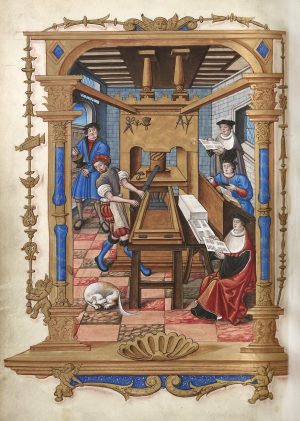
Plate showing the operation of a printing press, from Chants royaux sur la Conception, couronnés au puy de Rouen de 1519 à 1528, 16th century (Bibliotheque nationale de France)
Unsurprisingly, this flourishing industry generated wealth, cultural interest, and the diffusion of a new trend known as “bibliomania”—defined as a passionate enthusiasm for collecting and owning books. Readers and collectors from all over the world sought out the books of Venetian printers, who skillfully adapted production to demand. These printers created an inventory that was extraordinary in its variety, thanks also to the freedom of press granted by the government. It was in Venice that the first printed edition of the Koran was published, along with the first printed Talmud.
Books, booksellers, and bookstores
Anyone strolling through the bustling streets of Venice in the late 15th century would encounter bookstores whose windows displayed beautiful book frontispieces while catalogues of the books available either hung from the jamb of the door, or were available inside, on the counter. It was common practice for the bookseller to offer the loose pages of a book in a package which the buyer would subsequently arrange to have bound in accordance with his or her taste and financial means.
Bookstores soon became places where scholars, intellectuals, collectors, and book lovers gathered to discuss new editions, exchange information, and converse with the bookseller who often was also the publisher and the printer. The invention of movable type spawned an industry that led to the creation of a new professional figure, the printer-publisher, and a new business, the publishing house. The publishing house developed its own structure, investors, and also required legal advisors, due to the emergence of copyright issues.
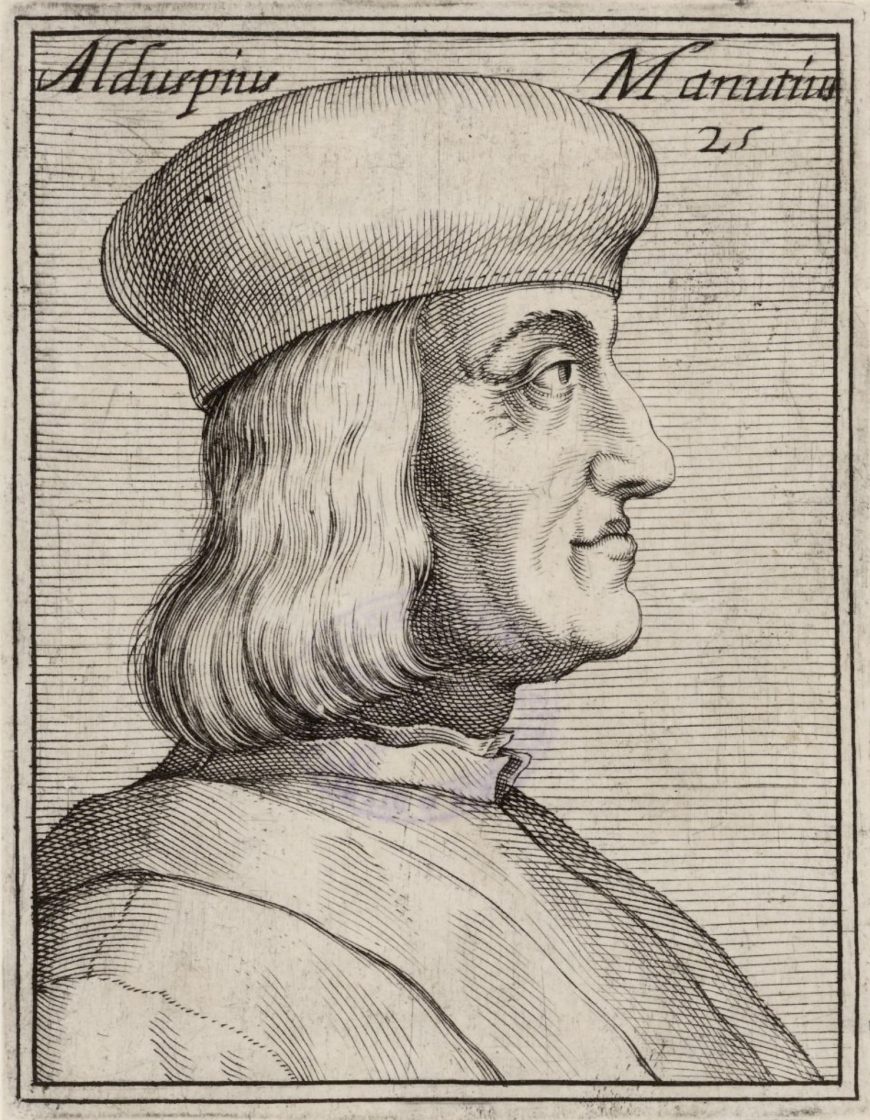
Portrait of Aldo Manuzio, n.d., print, 105 x 81 mm (Deutsches Buch- und Schriftmuseum, Deutsche Nationalbibliothek Leipzig)
Aldo Manuzio
“Venice is a place that is more similar to the rest of the world than to a city,” Aldo Manuzio wrote in a preface to one of his books. He arrived in Venice in 1490, driven by his profession as a Greek and Latin tutor. Manuzio was a humanist from a small town in central Italy, and it was probably his interest in books that brought him closer to the world of the printing press.
Manuzio was one of the first publishers in a modern sense. In a short time, he transformed the concept of the book in Europe thanks to his typographical innovations and to his unique editorial vision. He did this by founding and overseeing the Aldine Press, with the help of technicians, scholars, investors, as well as with political support. Aldine Press books were marked by a famous emblem depicting an anchor and dolphin and were known throughout the world for their accuracy, beauty, the superior quality of the materials employed, and their cutting-edge design.
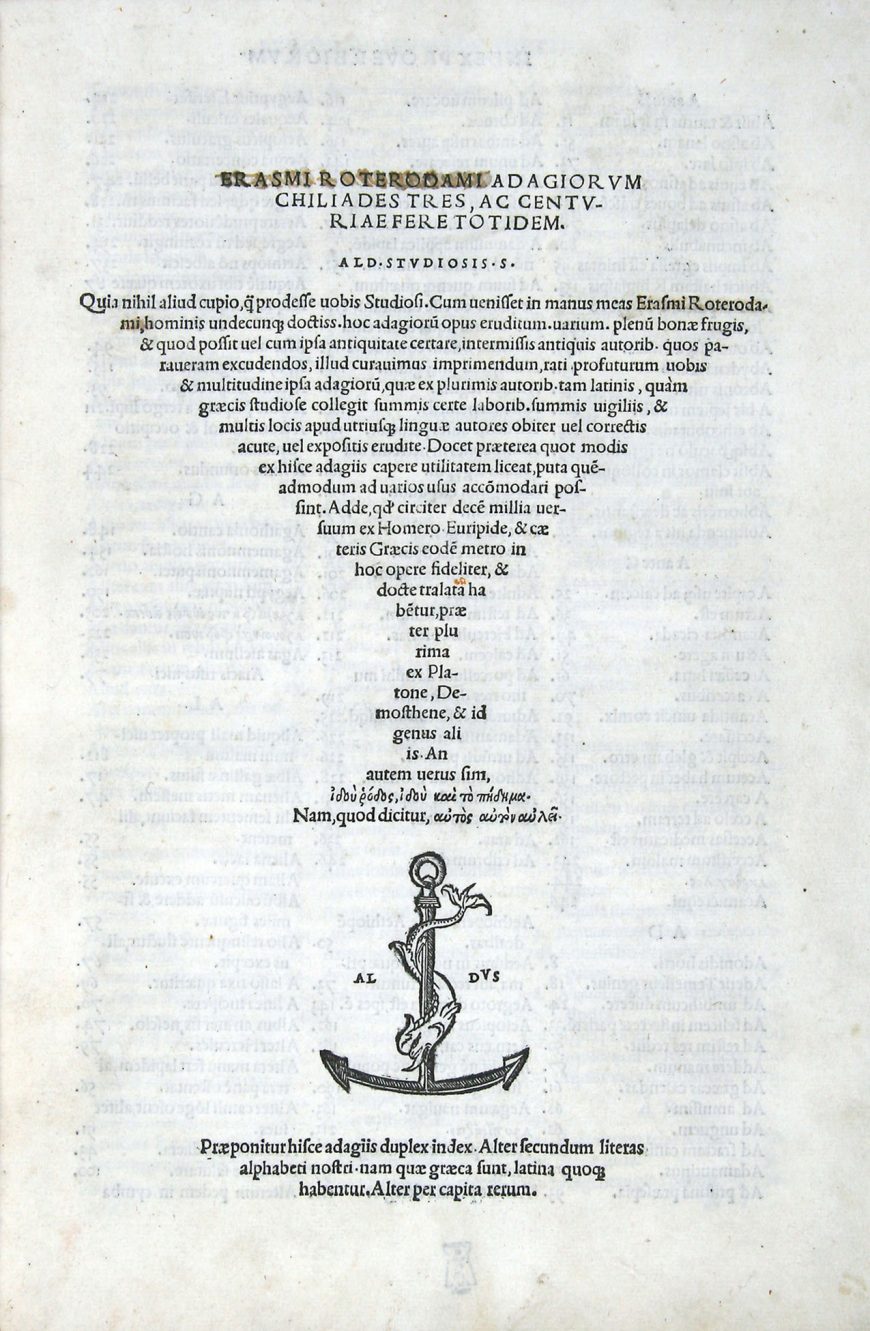
Erasmus of Rotterdam, Adagiorum chiliades, Aldine Press, 1508 (Bibliothèque Municipale, Tours, France). The Aldine Press emblem is visible at the bottom of the page.
Manuzio’s original intention was to spread Greek language and philosophy to a wider public. He subsequently produced books in Latin and Italian, publishing famous editions of Dante and Petrarch, as well as work by of some of his contemporaries, such as Erasmus. Over two decades Manuzio published 130 editions, 30 of which were first editions of Greek writers and philosophers.
Aldine editions stood out: from the first pages, Manuzio impressed the reader through the use of prefaces discussing his editorial work, his intentions and projects. In the preface, he would occasionally invite the reader to find and to report any errors in the text, thus actively engaging the reading public.
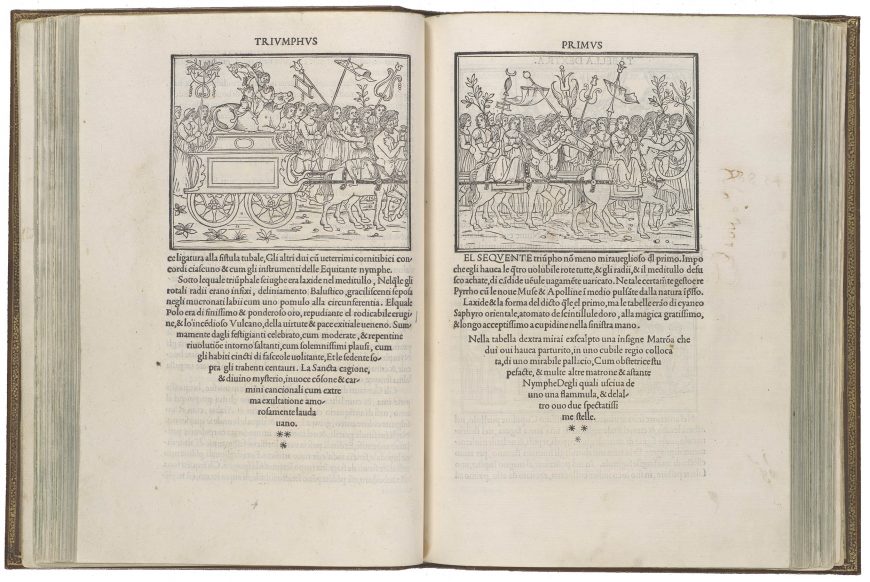
Francesco Colonna, Hypnerotomachia Poliphili, published by Aldo Manuzio, 1499, book with woodcut illustrations, 29.5 × 22 × 4 cm (The Metropolitan Museum of Art)
The inventor of the modern book
Many of the elements that Manuzio introduced, or eliminated, in the conception of his editions are innovations that have become embedded in today’s books. Notably, he gave a new look to the printed page: the pages of Manuzio’s books featured harmonic proportions between the size of the fonts, the printed section, and the white border, according to precise mathematical principles—reflecting a major theme in Renaissance culture.
Manuzio also introduced page numbers and made reading more fluid by clarifying the disorganized punctuation that prevailed at the time. He added a period at the end of the sentence and was among the first to adopt the use of the comma, apostrophe, accent, and semicolon in the ways they continue to be used today. In order to recreate the familiar effect of handwriting, he also invented what is now known in English as the “italic font,” named after it’s Italian provenance.
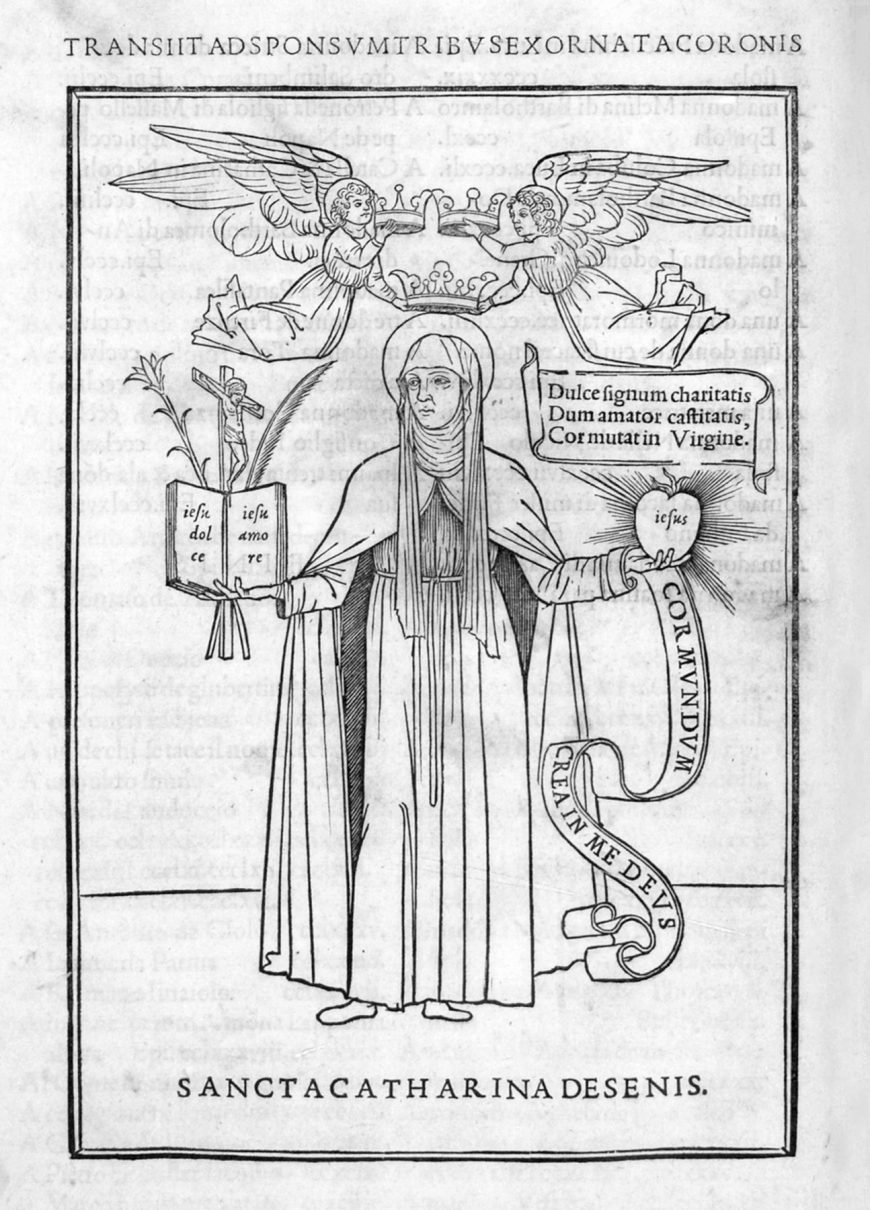
Epistole di santa Caterina da Siena, published by Aldo Manuzio, 1500 (Biblioteca Universitaria di Bologna). This is the first example of italic type (printed within the book on the left), which was developed for Manuzio by the typographer Francesco Griffo.
One of Manuzio’s most striking inventions was the printing of small-format books, the ancestors of our modern pocket-sized publications. Small religious volumes were already in circulation, but Manuzio’s revolutionary idea was to publish both classics and modern works in the small format.
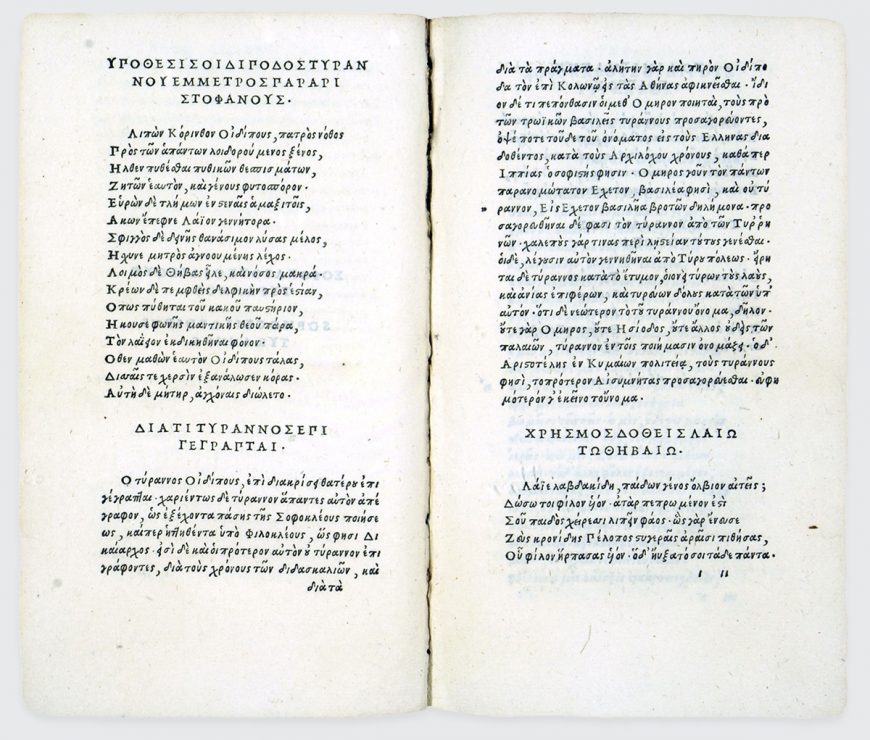
Sophocles, Tragaediae septem cum commentariis, 1502, published by Aldo Manuzio (Biblioteca Universitaria di Bologna).
It can be argued that through this innovation Manuzio also invented a new audience. With pocket-sized books, reading became an intimate moment, an activity that could be enjoyed while traveling, lying in bed, or sitting on a garden bench. For the first time, the book became a manageable, easy to carry, and relatively inexpensive object, therefore it became accessible to a larger audience comprised not only of scholars, but also of aristocrats and members of the upper middle class. The small books immediately became very fashionable and conferred a certain status, as we can see in many portraits of the time.
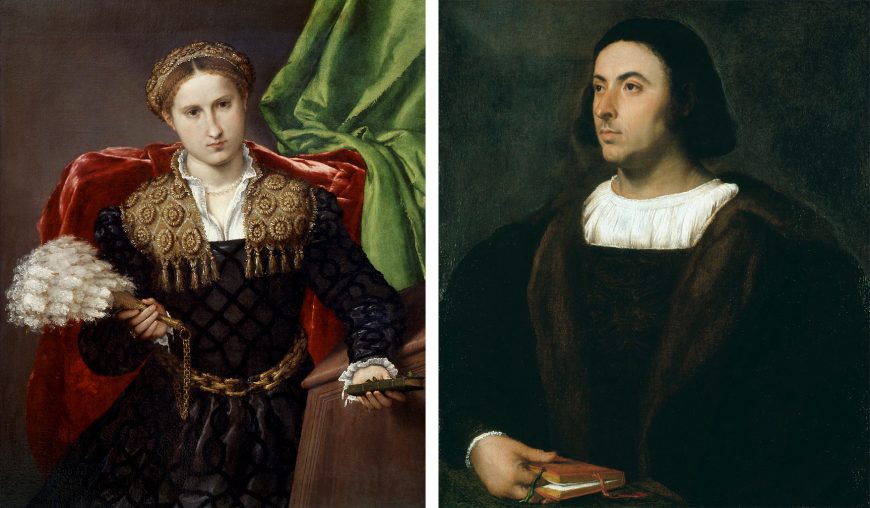
Left: Lorenzo Lotto, Portrait of Laura da Pola, 1543-44, oil on canvas, 90 x 75 cm (Pinacoteca di Brera); Right: Titian, Portrait of Jacopo Sannazaro, c. 1514-18, oil on canvas, 85.7 x 72.7 cm (Picture Gallery, Buckingham Palace, The Royal Collection Trust)
Sweeping away barbarism with books
The Aldine editions had a significant impact in Europe, imparting new momentum to the book market and creating a larger audience, that in turn stimulated culture and led to the spread of ideas. Erasmus praised Manuzio’s objective to “build a library that would have no boundary but the world itself.” Indeed, the power of a book is that it enables its readers to live many lives and to deepen their understanding of the entire world without ever needing to leave their homes. By reviving the classics and publishing modern works with rigor and beauty, Aldo Manuzio wished—in what has proven to be a timeless quote—that “it could be possible to defeat weapons with ideas and to sweep away barbarism with books.”
Additional resources:
Digital catalog for the Aldo Manuzio exhibition at the Gallerie dell’Accademia di Venezia
Guido Beltramini, Aldo Manuzio: il Rinascimento di Venezia (Marsilio, 2016)
Lodovica Braida, Stampa e cultura in Europa (Laterza, 2003)
Mario Brunetti, L’Accademia Aldina, in Rivista di Venezia, VIII, 1921
Carlo Dionisotti, Aldo Manuzio umanista e editore (Edizioni il Polifilo, 1995)
Gian Arturo Ferrari, Libro (Bollati Bolingheri, 2014)
Leonardas Vytautas Gerulaitis, Printing and Publishing in Fifteenth-Century Venice (American Library Association, 1976)
Paul Grendler, Schooling in Renaissance Italy: Literacy and Learning, 1300–1600 (Johns Hopkins University Press, 1989)
Mario Infelise, Aldo Manuzio: La costruzione del mito (Marsilio, 2016)
Mario Infelise, Manuzio, Aldo, il Vecchio, Dizionario Biografico degli Italiani – Volume 69, Istituto dell’Enciclopedia italiana Treccani, 2007
Jill Kraye, The Afterlife of Aldus: Posthumous Fame, Collectors and the Book Trade (Warburg Institute, 2018)
Martin Lowry, The World of Aldus Manutius: Business and Scholarship in Renaissance Venice (Cornell University Press, 1979)
Aldo Manuzio, Humanism and the Latin Classics, edited and translated by John N. Grant (Harvard University Press, 2017)
Giovanni Mardersteig, Aldo Manuzio e i caratteri di Francesco Griffo da Bologna, in Studi di bibliografia e storia in onore di Tammaro De Marinis (1964)

